A Visitors Report
|
Read more
at in70mm.com The 70mm Newsletter |
| Written by: Thomas Hauerslev | Date: 26 February 2007 |
 Real
showmanship by Schauburg manager Mr. Herbert Born - had a printed
special Todd-AO Festival Poster, flyer and brochure made for the guests. The
poster was seen all over Karlsruhe. Real
showmanship by Schauburg manager Mr. Herbert Born - had a printed
special Todd-AO Festival Poster, flyer and brochure made for the guests. The
poster was seen all over Karlsruhe.In October 2006 I went to Karlsruhe in southern Germany for a second time to enjoy a weekend of classic films in their large, state-of-the-art, Super Cinerama 70mm cinema. I would be spending much of the weekend looking at the big curved screen for up to 10 hours a day, three days in a row, enjoying the sweeping splendour of oversized and razor sharp images, and the fidelity of 6 discrete magnetic stereo tracks. Experiencing the breathtaking scope of a huge cinema, the gong, curved seating and good German beer. If this is the first time you are reading about "70mm", "magnetic" and "super Cinerama" you are probably confused.
And you have every right to be confused, as these terms are restricted to an
extremely select type of films primarily produced from 1955 until the early 1970s. During that
15+ year stretch, a little more than 60 films were photographed on 65mm
large format film. This high-end format was only used for the most
prestigious musicals and epic large scale films produced by the major
studios in Hollywood, Britain and West Germany plus to some extent in East
Germany and Russia. |
Todd-AO Festival Home • 2nd Todd-AO Festival • Wilkommen | Welcome • Intro | Festival Images • Festival Flyer (PDF) Festival Archives • Festival Through the Years • Festival Schedule and Archive • More Schauburg Cinerama Festivals in Pictures • Schauburg Cinerama • Best of Todd-AO Festival • Guests | Billboards | Posters Internet link: • Schauburg.de |
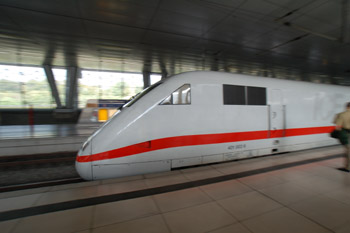 The overall subjective experience of the grandeur, presentation,
stereo sound, intermissions, music, clarity and sharpness often left an
unforgettable memory of the film, a memory which stayed with some people for
decades. The memory remained especially vivid because the presentation was
"in 70mm with 6-track magnetic stereo" (the 65mm negative is printed on to 70mm film to provide space
for the magnetic striping on which the sound is recorded.).
With few
exceptions,
the use of 65mm large format film has been, largely, abandoned since 1970.
This true high definition film format is only kept alive by a very few
professionals in the production and exhibition industry. The management of
the Schauburg cinema is an enthusiastic 70mm believer and, since 2005, has
repeatedly presented 70mm films where they belong - on the huge curved
screen. The overall subjective experience of the grandeur, presentation,
stereo sound, intermissions, music, clarity and sharpness often left an
unforgettable memory of the film, a memory which stayed with some people for
decades. The memory remained especially vivid because the presentation was
"in 70mm with 6-track magnetic stereo" (the 65mm negative is printed on to 70mm film to provide space
for the magnetic striping on which the sound is recorded.).
With few
exceptions,
the use of 65mm large format film has been, largely, abandoned since 1970.
This true high definition film format is only kept alive by a very few
professionals in the production and exhibition industry. The management of
the Schauburg cinema is an enthusiastic 70mm believer and, since 2005, has
repeatedly presented 70mm films where they belong - on the huge curved
screen.Since it is so rare to see 70mm in the right conditions I was pleased to learn that Mr. Herbert Born, the manager of the Schauburg cinema, had decided to celebrate the 50th anniversary of Todd-AO back in 2005 with a festival of films. I went there to give a lecture. The weekend had been unforgettable, presentations were outstanding, the beer was good. So I decided to give it another try in 2006. Several months of anticipation and planning came to the fore when my 8 year old son August and I boarded the plane from Copenhagen to Frankfurt am Main at half past 10 in the morning. August had never been to a film festival and he looked forward to a nice weekend with dad (not least because I had promised him to go to McDonalds in Karlsruhe). I had previously, on two occasions, brought my now 12 year old daughter Maria to the Widescreen Weekend in Bradford [UK]. This time, I felt it was August's turn to experience a film festival. It is easy to go to from Copenhagen to Karlsruhe. The airplane to Frankfurt, followed by a fast ICE train from the airport to Karlsruhe, via Mannheim. We met Mr. Duncan McGregor from Bradford on the platform while waiting for the train. On the train we had a cup of tea while the German landscape passed by. In Karlsruhe we checked into the Dorint hotel, a very nice hotel and only 5 minutes walk from the cinema. August and I stayed in a comfortable room which had a view to the street and the trams. Karlsruhe is noted for its public transport system, largely done by modern trams. |
|
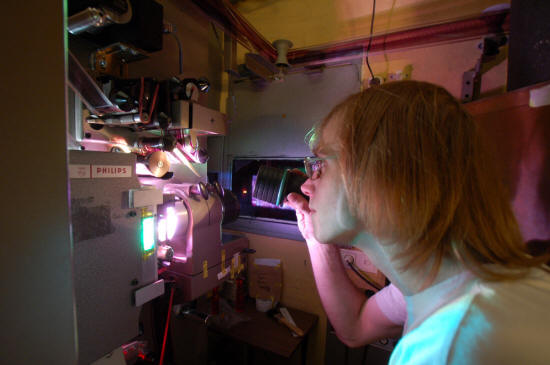 Baraka BarakaThe first 70mm film of the 2nd Todd-AO Weekend at the Schauburg was "Baraka". "Baraka" is an ancient Sufi word and is best translated as a blessing, or the breath, or essence of life, from which the evolutionary process unfolds. "Baraka", the epic non-verbal film, tells the story of the earth's evolution, man's diversity and interconnection, and his impact on the planet. According to director Ron Fricke, "It is a journey of rediscovery that plunges into nature, history, the human spirit, and finally into the realm of the infinite". The film was shot on 65mm in 24 countries, in such diverse locales as Brazil, Nepal, Cambodia, Kuwait, India, Tanzania and Iran. "Baraka" won the 1992 "Best Picture" (Hors Concours) International Film Critics Jury Award at the Montreal Film Festival. All "Baraka" 70mm prints have been struck from the original camera negative, which makes all the 70mm prints "show prints", a type of print which is often earmarked for a few high-profile cinemas in major cities. Those are located where most of the movie-making people live, and they benefit from the excellent quality of a print struck directly from the camera negative. Ron Fricke's previous films include "Chronos" and "Sacred Site", both filmed in IMAX Dome (formerly Omnimax). (Mr. Fricke is currently working on a new large format film, with the working title: "Samsara".) "Baraka" has lived a very unusual life. It is an independent film and has been shown continuously since the original 1992 release in countries around the world. It is always a crowd pleaser and continues to stun the audience with fantastic 70mm images. August and I didn't see it this time around, however. It is always a breathtaking experience to see "Baraka" in 70mm, but I have seen it plenty of times and even showed it myself at the Danish premiere in 1992. Grand Prix I looked forward to seeing "Grand Prix" again. I had seen it previously in Bradford in 1999 and was eager to experience John Frankenheimer's film on the curved screen. In Bradford I went for "the front row experience", but in Karlsruhe, I sat 2/3 back from the screen, and had a splendid view of the wide curved 70mm screen. Mr. Wolfram Hannemann introduced / And a pleasant experience on the big curved screen! I've often wondered why I think a curve is better than a flat screen. I believe it is due to the history of Cinerama and Todd-AO. In those days, screens were deeply curved, to enhance the illusion of participation. But that illusion was also enhanced through the use of wide angle lenses. Wide angle lenses were abandoned early on and essentially so was the need for the curved screen, but the screens were not replaced and stayed for many years. I was brought up with them in the late 1970s, and feel a curve adds to the spectacle and grandeur of moviegoing. I think a flat, rectangular screen looks dull compared with a curve. It looks like TV, which I don't think is desireable when going to the cinema. One drawback of the curve though, is cropping of the frame, which means a part of the film frame is not seen on the screen. Generally, the image is cropped [cut] more and more, the deeper the curve of the screen. In this respect, a flat screen is preferred. The Schauburg curve is moderate and not too deep. I believe it is a 90 degree curve. The "Grand Prix" 70mm print was an original copy from 1966 and very faded. "Faded", in layman's terms, means the blue and green dyes have disappeared from the film strip. Since "Grand Prix" dates back over 40 years, only the red colour has survived due to the effects of age and storage of the film over the years. In a way, it is a minor miracle that 70mm film prints like "Grand Prix" have survived at all since the original release 4 decades ago. Which makes it all the more enjoyable to watch it, despite the severe fading. This vintage 70mm print was incredibly sharp, almost three dimensional. The resolution of the large 70mm format (which is 3˝ times larger than standard 35mm film) is amazing. The images "pop" out of the screen. The film is rock steady, camera is not shaking, and it makes the viewing even more pleasurable. In 2005 a new 70mm print was struck for a "one off" screening in Los Angeles. The print is stored in the Academy's vaults in Los Angeles, but the print has no sound or DTS time code. The 6 track sound was played separately in synch with the film, and the digital player has since been reformatted and been used for other purposes. We can only hope the print will be magnetic striped and recorded so that it can bee seen elsewhere. The film is out on DVD - made from a master struck from that 70mm print. Maurice Jarre's score sounds very much like his scores from "Lawrence of Arabia" and "Doctor Zhivago". At least it was impossible not to notice that. There was an intermission during which August and I met with friends from Germany, France, the US and Holland. I drank one of the local beers - Hoepfner Brau. After the film we went back to the hotel to have supper. August was tired from the day's travel and we both needed all our energy for Saturday. On our way out of the Schauburg I enjoyed looking at the poster and image display of the films of the weekend. Herbert Born had had a special "Grand Prix" poster created which looked truly spectacular. |
|
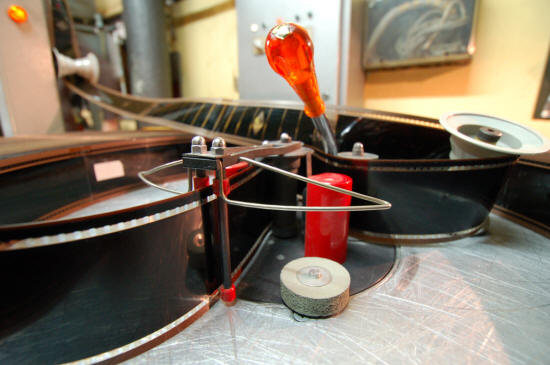 Spartacus SpartacusI didn't see "Spartacus" this time. I had had the pleasure of running the restored Super Technirama 70 version of "Spartacus" in Copenhagen when it was released in 1992. It's a spectacular film with many great performances and wonderful music. Saturday August and I woke up very early and went down to the breakfast buffet in the hotel restaurant. The Dorint has a great morning buffet where we supplied ourselves with plenty of bread, juice, tea, fresh eggs and sausages. August was particularly fond of the large selection of food and he consumed considerably more food than he usually does when he's at home in Copenhagen. August's first day as a festival attendee had been one film. Saturday, he was in for two films with an intermission. Between the films we tried to find a McDonalds, which I (in a weak moment) had promised him. I explained to him what the films were about: "Mutiny on the Bounty", a true story about a real event which took place many years ago. The second one: "took place during war time and had great songs". He didn't sound too excited but at least he knew what he was in for. So, we brushed our teeth and walked to the Schauburg in Marienstrasse to say good morning to Herbert and friends. Herbert was very busy making breakfast for the customers and festival guests. What I thought was a special 70mm weekend treat, turned out to be a regular, on-going affair at the Schauburg every Saturday and Sunday. A huge, lavish breakfast table is set up in the main foyer an hour before the first show each weekend. The audience is treated to fresh bread, tea, coffee and everything your taste desires. August and I could have a second breakfast if we needed it. |
|
|
Mutiny on the Bounty Prior the the 2nd Todd-AO Festival, the only film I had not seen in its 70mm version was "Mutiny on the Bounty". I really looked forward to that as it was to be shown in the original format: Ultra Panavision 70. Ultra Panavision 70 is a 65mm/70mm process with an extremely wide image on the screen. The aspect ratio is around 2,76:1. Which means the relative width of the screen is 2,76 times wider compared the height of the screen. On the film strip, the image of photographed with a special anamorphic lens which squeezes the image with a factor of 1,25 in the horizontal plane. When the film is projected, a similar anamorphic attachment is used in front of the projection lens to un-squeeze the image back into the correct proportions. It is very unusual to find a cinema with an original Cinerama screen, a functional set of Panavision projection lenses and an original 70mm print. But the Schauburg, in the best German tradition, has it all. And everything is in mint condition to make the presentation look as spectacular as possible. The night before Herbert Born and his crew had attempted to mask the screen down to fit the film, but alas, the idea had to be abandoned. The result was a very wide, very sharp image across the curve. The print still retained it's intermission title card but the entire print was faded to pink. The 6-track magnetic sound was still good. How many original Cinerama cinemas can still project Ultra Panavision 70 today? The number must be less than a handful - which is all the more reason to visit the Schauburg in October 2007, when more Ultra Panavision 70 films will be shown. The film was introduced / We found a fast food place in Karlsruhe and had a burger and something to drink. |
|
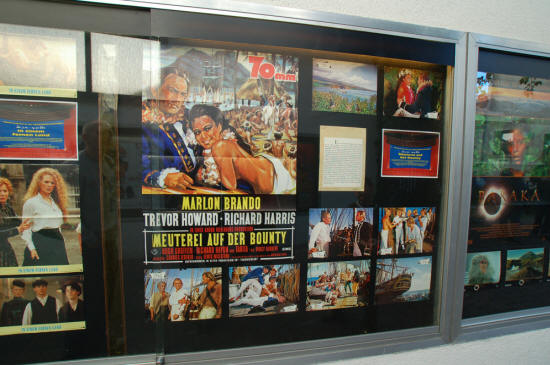 The
posters are important at the displays The
posters are important at the displaysWe returned to see the final reel of the film on the curve. "Far and Away" looked great and has a fantastic Dolby sound, but is not particularly stereophonic. Most of the dialogue comes out of the center channel. Mikael Salomon's cinematography is outstanding and for the Bradford Widescreen Weekend he kindly had written a short introduction on why "Far and Away" ended up being shot in 65mm. "South Pacific" August and I returned to see "South Pacific" in Todd-AO and 6-track DTS sound. Again the film was introduced / After "South Pacific", August and I went home to the hotel to to eat and relax. August had "movied out" for the day and would probably not "survive" another 3+ hours of "Titanic". "Titanic" is one of my favourites and I saw it several times in 70mm when it opened in Copenhagen in January 1998. I have been fascinated by the story of the ship for many years and have even visited several exhibitions in Copenhagen and Hamburg about the items found at the wreck. "Titanic" is officially the last 70mm release of a contemporary film - and only 12 70mm prints were struck - one of which went to Mr. Cameron himself (the director). It is still a very entertaining and successful film, to say the least. It saved the economy of many cinemas when it was released. It remains the most financially successful film of all time. It was filmed in Panavision System 35 (aka. "Super 35") and optically enlarged to 70mm (blown up). Despite the fact that System 35, is "flat" 35mm the blow-up looked stunning. Very rich blue, green and red colors. This print came from the Dutch film archive in Amsterdam and it required special clearance from Fox to release the print. The film was introduced / |
|
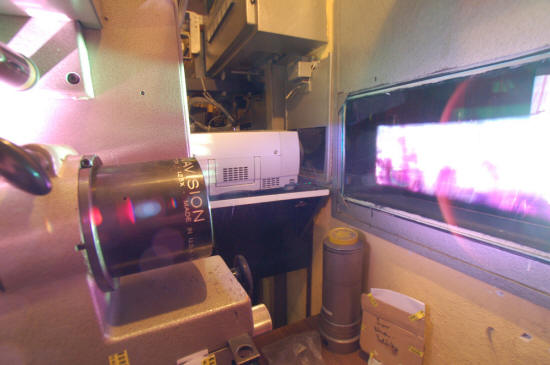 The
Panavision projection lens on the Philips DP75 projector -note the pink
light due to the faded condition of the print. The
Panavision projection lens on the Philips DP75 projector -note the pink
light due to the faded condition of the print.Sunday August was beginning to wear out and was not really too keen on seeing multiple films, and especially older films, even if in 70mm. My daughter Maria, on the other hand, enjoys sitting all day watching old movies with dad. Anyway, the night before I had explained to August what a "marathon" was and the fact that we were going to see films most of Sunday. 10 hours to be exact. He braced himself and looked forward to try a "movie marathon" so he could tell his friends at school afterwards. And as we were having breakfast at the hotel he looked forward to doing it and then returning to Copenhagen. I had also promised him that he might play with his GameBoy during the films, provided none of the other guests were bothered by the light from his small GameBoy screen. I also explained to him that we were going to sit on the right side of the cinema all Sunday as I had a part to play for the Sunday morning show. 09:00 Breakfast buffet before the 10 o'clock show Sunday morning is, like the Widescreen Weekend in Bradford, dedicated to short films. And this particular morning we also celebrated the 75th birthday of cinematographer Robert Gaffney, and we even had three of his films to see. For several weeks in advance I had corresponded with Sherry Gaffney and built up a small tribute for him on in70mm.com. Additionally, I had tried to assemble the cast/credits for his short film. Not an easy task, but nevertheless I attempted to do it. The running order of the show was like this: We started by saying good morning and then explained the Bob Gaffney story to the audience. Then I introduced Mr. Dieter Gaebler who was Bob Gaffney's assistant when they made the 65mm short films. Dieter gave the audience an introduction to the films and reminisced about the process of large format film making. He also linked the films very nicely. We began the show with "Fortress of Peace", continued with "Motion" and the "Stuyvesant" cigarette commercial, and finished the tribute with the award-winning "Sky over Holland". The show continued with the Russian short film "Only Girls of the Sky" in Sovscope 70 and the "Die Macht des Lövens" in 70mm mono, an MGM trailer promoting the company's new films in production in 1967. The English title is "Lionpower from MGM" (1967). It is a full reel (27 minutes) of clips from coming MGM titles. It was faded Metrocolor but all the same a nice piece of movie memorabilia. The final part this Sunday morning was a Q/A session with Dieter Gaebler about the 70mm short films. The Q and A was followed by lunch for weekend guests. |
|
 Guest
of honour, Mr. Dieter Gaebler introducing the films of Robert
Gaffney and giving a Q & A after the films. Guest
of honour, Mr. Dieter Gaebler introducing the films of Robert
Gaffney and giving a Q & A after the films.After the lunch break we continued with the classic 70mm blow up of "Where Eagles Dare", about English espionage during World War II. The film was a German language dub, which I didn't mind. I know most of the dialogue by heart anyway. The intermission music of this print had been lost, so the projectionists included the intermission music and entr'acte from the LaserDisc version. Nobody noticed and once again the dynamic duo in projection saved the day for the audience. This was the only film my son August liked during the weekend! And I must agree with him: it is superb entertainment and they surely don't make them like this any more. There are so many good parts in the film so it is difficult to single out one of them, but I must say that Derren Nesbit is still especially creepy as Von Hapen the Gestapo officer. Perhaps the most eagerly-awaited 70mm title to get a new print treatment this year must surely be "Cleopatra" in this 4 hour version. I'd seen the film in Todd-AO previously in Malmř (Sweden) about 7 years ago but that was a badly scratched and faded print. But at that time, that was the only opportunity to see it. This new print is a revelation and stunningly amazing. The sharpness and colors are fantastic. The first part with Rex Harrison is the best and most dynamic. Part two, with Richard Burton is, for me, too theatrical or over acted. Anyway, Liz Taylor's cleavage is gorgeous and, the mere fact that a new Todd-AO print is available makes the fours hours running time fly by - like, well four hours of delicious eye candy. The production just pops off the screen. Alex North's music is good. August slept for an hour during "Cleopatra", but I don't think he noticed what he missed. For its' day it was the most expensive film ever made, and you can see why. On the other hand it was also one of the most admired films of the decade and it was seen by a lot of people. I'm not quite sure when it finally broke even, but I seem to recall it was sometimes during the 1970s. August was happy when "Cleopatra" ended, as it meant going back to the hotel for him. It had been a very long day, but he completed his movie marathon with excellence. Not a single moan from him, or questions about when the films were over. He rose to the occasion. I'm amazed that he sat through 10 hours of movies. Obviously we didn't see the final film of the Sunday program as we'd returned to the hotel. In 1991 I was fortunate to show "T2" in 35mm CDS in Copenhagen's jewel of a cinema - the Imperial Bio. 6 channels of uncompressed sound was staggering in 1991. I have never seen it in 70mm Dolby Stereo, and must wait until the opportunity arrives another time. |
|
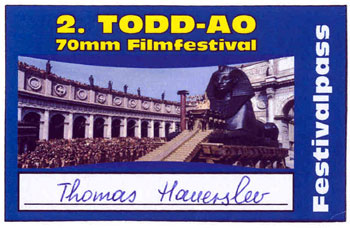 Conclusion Conclusion- why travel 1000 km to see old films? Was it worth it? I always enjoy watching movies. And for nearly 30 years I've been fascinated by 70mm films. When an opportunity like going to Karlsruhe and see 70mm as originally intended, in a venerable flag ship cinema with the original 18 meter wide curved screen still intact presents itself, it is difficult to say no. On top of that, when the company is also good and the beer is excellent, count me in. The Schauburg cinema, managed by Herbert Born, is as I said previously state-of-the-art and the management seems to be continuously investing in new technology - lately with a Kinoton digital projector. The image and sound are top notch much thanks to the "dynamic duo" of Koch and Vetter in projection. They really know their work. At the same time, it is discouraging to see how few people actually come to see these old movies. It is a receding history with fading prints. The only film I had not previously seen in 70mm was "Mutiny on the Bounty" in Ultra Panavision 70. That was truly the high point for me. Truth to be told some of the movies are not really all that good, and 70mm doesn't make them that much better, except maybe a little bit thanks to the 6-track sound and big and razor sharp images. But even so, it is amazing to see these old 70mm films coming to life in perfect conditions on the Schauburg screen. I would recommend to anyone to take a weekend off and go to Karlsruhe and enjoy the spectacle of 70mm - it is indeed worth the effort. Especially when you get the original surroundings - like the majestic Schauburg - as a bonus. The next Schauburg opportunity will be in October 2007. I'm looking forward to seeing you there, in fact I have already purchased my ticket. |
|
|
Go: back
- top -
back issues
- news index Updated 21-01-24 |
|
